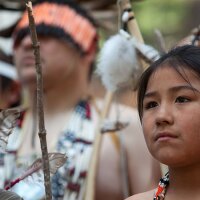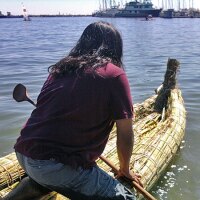Healer, Weaver, Activist: Traditional Ecological Knowledge and Mabel McKay

For Mabel McKay, the renowned Pomo basket weaver, traditional doctor, and last speaker of her language, her relationship with the environment was an intrinsic part of life. She had a spiritual connection to the plants she wove into her baskets, a deep respect for the birds she used for her feather work, and longstanding ties to the cultural traditions of her ancestors. Interviewed for an article in the magazine American Indian Basketry in 1983, Mabel said: “collecting the sedge is spiritual, just like weaving the basket is spiritual.”
Mabel was born in 1907 and passed away in 1993. Over the course of her lifetime—which nearly spanned the entirety of the twentieth century—she would have experienced an enormous amount of social and political change. Born in Lake County in the town of Nice, California and raised near Cache Creek (now the present day Yocha Dehe Wintun Nation about forty minutes south of Sacramento), she witnessed the landscape around her changing. Pomo territory is very environmentally diverse, ranging from the coastal redwood forests of the Kashaya Pomo reservation near Fort Ross to the rolling grasslands and oak groves near Clear Lake.
When Mabel was born, there were only six members of her tribe the Long Valley Cache Creek Pomo remaining, and approximately 700 members of all of the other Pomo groups. This number was in sharp contrast to the over 20,000 Pomo people who lived in the area prior to contact; in less than a century, disease, violence, and outright targeted extermination efforts had led to devastating population loss. Remarkably, Mabel was able to preserve her traditions into the late twentieth century, especially given the fact that there were so few members left to continue these cultural practices.
One of the things that sets Traditional Ecological Knowledge (TEK) apart from other disciplines is the manner in which it is passed down. Indigenous cultures around the world transmit this knowledge through oral tradition, with elders teaching the next generation. TEK is learned through observing nature, developing a close relationship with the environment, and as is often linked with spirituality. For Mabel McKay, her life was guided by the Spirit, which spoke to her in dreams and instructed her on basket weaving and doctoring.
When Mabel was young, she suffered from a series of illnesses. As a result, she never finished formal schooling past the third grade. Yet she was exceptionally knowledgeable about plants, seasons, and water systems. She learned to gather medicinal plants from her Wintun maternal grandmother Sarah Taylor, and in turn passed this knowledge down to Nomtipom Wintu herbalist and ethnobotanist Sage LaPena.
Mabel used a variety of medicinal plants in her healing, including Artemisia or mugwort, manzanita, angelica, and yerba santa, all of them native to California. These plants are used to treat a variety of ailments from stomach aches to menstrual cramps. Though she technically had only a third grade education and did not receive her driver’s license until age sixty, Mabel McKay shared her knowledge by consulting with museums and speaking at universities, including prestigious institutions like Stanford University Medical School.

Mabel’s knowledge of plants—used for both healing and basket weaving—was extensive. In the late 1970s, Mabel began to teach basket weaving classes to a group of dedicated students, both Native and non-Native. She was willing to teach anyone as long as they were able to listen and adhere to her rules. Long before any of her students started weaving, they had to learn to properly gather and prepare their materials. It would often take up to two years before her students could start working on a basket. Mabel would take her students out gathering, teaching them the proper ways to tend and maintain basketry plants, and when they could gather.
Knowledge of seasons is essential for gathering basketry plants. For example redbud, one of the primary design materials in Pomo baskets, must be gathered in the fall to produce the desired red effect. Redbud gathered in the summer is white. In keeping with Pomo tradition, Mabel exclusively used redbud for the red designs in her baskets. She also taught her students about birds and other animal species, and their relationship to the plants. When consulting on a display of a sedge bed in a past exhibit at the Natural History Museum of Los Angeles County, Mabel insisted that a blue jay be included as jays give warning of danger approaching, like an adjacent predator.
Sedge, or k’uhum in the Northern Pomo language, is one of the most important plants for Pomo basket weavers. Sedge requires generations of tending, to ensure that the roots grow long and straight. The roots need to flourish in sandy soil, free from rocks and debris. Mabel’s son Marshall reflects that she was always able to find the longest sedge roots, often several feet in length. Prior to digging sedge, Mabel would say a prayer. To her, the relationship between people, plants, and the spirit world were one. It was Mabel’s relationship with the plants that she gathered that led her to protest the construction of the Warm Springs Dam in northern Sonoma County.
In the late 1960s, a dam site was proposed on Dry Creek, a tributary of the Russian River, as an effort to curb the flooding of adjacent vineyard properties. A citizen’s task force, consisting of both Pomo people and non-Native residents wanting to protect the land, formed to fight the project in court. Although they could not stop the construction, the court case prompted a reassessment of the site from a cultural resources perspective. Mabel was part of the Native American Advisory Council to the project; the Council worked alongside archaeologists, historians, linguists, and botanists to document the cultural impact of the site. The area was not only the ancestral village site of the Mihilakawna, or Dry Creek Pomo, but also home to sedge beds that had been tended for generations. As part of the project, the weavers transplanted thousands of sedge beds in an attempt to save the plants.
Bob Orlins, one of the lead archaeologists for the Warm Springs Dam project, lamented the inevitable construction in an article for New West magazine: “the basket makers will tell you that, that the roots just aren’t the same. And how could they be? It isn’t the same place they went to gather sedge as little girls with their mothers, where their grandmothers and great-grandmothers went. On back several thousand years. To me that right there is reason enough not to build a dam.”
Despite the efforts of Mabel and her fellow weavers, the cultural and environmental importance of the area was not enough to stop the construction. The dam was erected in 1982, completely submerging the area with what is now Lake Sonoma, in one of the most popular wine tasting regions in Northern California. Today, very few visitors to the area likely realize the deep history of the land and what was lost.
TEK is more than just passing down knowledge of cultivating, maintaining, and managing landscapes and plants. It is also activism—protecting and advocating for places like the Warm Springs Dam site. Mabel McKay embodied all of those things, and continues to serve as an inspiration to others committed to cultural and environmental preservation.
Banner: Mabel’s son Marshall McKay at present day Cache Creek. Photo: Paige Bardolph

Co-produced by KCETLink and the Autry Museum of the American West, the Tending the Wild series is presented in association with the Autry's groundbreaking California Continued exhibition.





